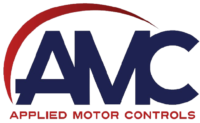Installation & Maintenance Instructions
Before Installing
- Check cabinet and parts for any potential shipping damage
- If any damage is observed, report immediately to the delivering carrier and file a freight claim. If possible take photographs as evidence of the damage
- For any repair or replacement, contact Applied Motor Controls’ home office
- Do not return panel or parts unless written authorization is provided
Installation
- Fasten cabinet to a solid mounting surface, and level the panel to allow for proper operation of its door
- When conduit enters through the top, a properly sized and sealed conduit hub must be used to prevent leakage into the cabinet interior
- Check supply power and confirm that it matches the panel and motor voltage
- INSPECT AND TIGHTEN ALL ELECTRICAL CONNECTIONS BEFORE ENERGIZING PAN-EL. FOLLOW THE TORQUE VALUES GIVEN FOR EACH TERMINAL/DEVICE. DO NOT OVER-TIGHTEN CONNECTIONS
- Terminate power supply cable at line terminal of main disconnect. Measure line-to-line and line-to-ground voltage values
- Prior to connecting the motor cables, test the motor starter operation. Close the pan-el door and turn the power on, then turn the Hand/off/Auto to the “hand” mode. The motor starter should energize and close.
- If motor starter does not energize, check for power continuity, blown fuses, and check starter coil voltage. Call the factory for technical support if necessary
- Tighten line and load cables according to the given torque values to prevent over-heating
- Use 75°C copper cable only
- Follow motor manufacturer’s instructions for proper grounding of motor cables
- Operate disconnect handle mechanism on the door to insure that interlock mecha-nism operates properly and it prevents door from opening when the handle is in the ON position
- If an overload relay with adjustable trip point has been provided, set the trip point to match the Full Load Amps shown on the motor data nameplate
Maintenance
- RISK OF ELECTRICAL SHOCK – More than one disconnect may be required to de-energized the equipment before servicing
- Inspect panel periodically to insure that all moving parts operate freely
- Interior should be kept clean. Excess dust, insects, debris, and foreign materials must be removed routinely
- Inspect magnetic contactor contact points for wear at least once every six months. Worn contact points must be replaced. Contact points can be cleaned with an appro-priate cleaner, but must never be filed
- Visually inspect all cable terminations. Discoloring of any terminal or wire indicates a loose connection
- TIGHTEN ALL CONNECTIONS TO PREVENT CABLE AND TERMINAL OVERHEATING
Replacement Parts
- When replacement of any part is necessary, the replacement part must be of the same electrical ratings and characteristics
| Enclosure Rating | NEMA (Standard 250) | UL (UL50 and UL508) |
|---|---|---|
| Type 1 | Enclosures intended for indoor use primarily to provide a degree of pro-tection against contact with the en-closed equipment or locations where unusual service conditions do not ex-ist. | Indoor use primarily to provide protection against contact with the enclosed equip-ment and against a limited amount of fall-ing dirt |
| Type 3 | Enclosures intended for outdoor use primarily to provide a degree of pro-tection against windblown dust, rain, and sleet. Undamaged by the for-mation of ice on the enclosure. | Outdoor use to provide a degree of pro-tection against windblown dust and wind-blown rain. Undamaged by the formation of ice on the enclosure. |
| Type 3R | Enclosures intended for outdoor use primarily to provide a degree of pro-tection against falling rain and sleet. Undamaged by the formation of ice on the enclosure. | Either indoor or outdoor use to provide a degree of protection against falling rain, splashing water, and hose-directed water. Undamaged by the formation of ice on the enclosure. |
| Type 4 | Enclosures intended for indoor or out-door use primarily to provide a de-gree of protection against windblown dust and rain, splashing water, and hose-directed water. Undamaged by the formation of ice on the enclosure. | Either indoor or outdoor use to provide a degree of protection against falling rain, splashing water, and hose-directed water. Undamaged by the formation of ice on the enclosure. |
| Type 4X | Enclosures intended for indoor or out-door use primarily to provide a de-gree of protection against corrosion, windblown dust and rain, splashing water, and hose-directed water. Un-damaged by the formation of ice on the enclosure. | Either indoor or outdoor use to provide a degree of protection against falling rain, splashing water, and hose-directed water. Undamaged by the formation of ice on the enclosure. Resists corrosion. |
| Type 12 | Enclosures intended for indoor use primarily to provide a degree of pro-tection against dust, falling dirt, and dripping non-corrosive liquids. | Indoor use to provide a degree of protec-tion against dust, dirt, fiber flyings, drip-ping water, and external condensation of non-corrosive liquids. |
